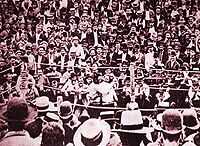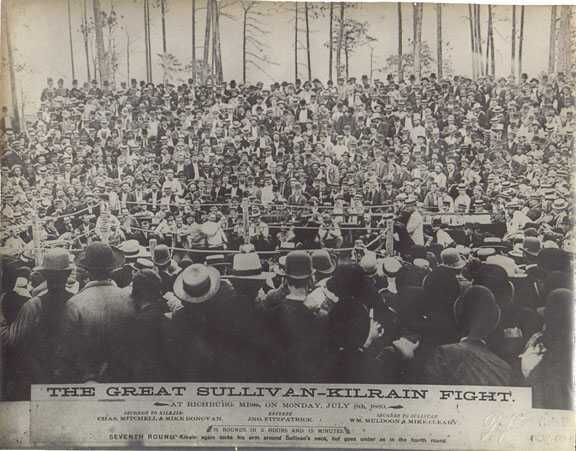

Sullivan Kilrain Fight On Monday, July 8, 1889, history was made in the small sawmill community of Richburg, Mississippi,
located three miles south of Hattiesburg, Mississippi, and 104 miles northeast of New Orleans,
Louisiana. This was the site chosen for the last professional bare-knuckle boxing match in America,
between heavyweight champion, John L. Sullivan
and the challenger, Jake Kilrain. Selection of this
rather obscure hamlet was due to the need for secrecy. At that time, bare-knuckle fighting was
illegal in all the existing thirty-eight states, which is not surprising, considering the London
Prize Ring rules, under which the sport was conducted: no gloves were worn; wrestling techniques
were permitted; a round lasted until one fighter was knocked down; and a fight lasted until one
fighter was unable to get up off the floor.
On Monday, July 8, 1889, history was made in the small sawmill community of Richburg, Mississippi,
located three miles south of Hattiesburg, Mississippi, and 104 miles northeast of New Orleans,
Louisiana. This was the site chosen for the last professional bare-knuckle boxing match in America,
between heavyweight champion, John L. Sullivan
and the challenger, Jake Kilrain. Selection of this
rather obscure hamlet was due to the need for secrecy. At that time, bare-knuckle fighting was
illegal in all the existing thirty-eight states, which is not surprising, considering the London
Prize Ring rules, under which the sport was conducted: no gloves were worn; wrestling techniques
were permitted; a round lasted until one fighter was knocked down; and a fight lasted until one
fighter was unable to get up off the floor.
The match evolved because of long-standing animosity between Richard Kyle Fox and John L. Sullivan. Fox was publisher of the National Police Gazette, a weekly publication devoted to sports and the theater. Sullivan had publicly humiliated Fox in 1881 by refusing to visit his table in a Boston saloon. From that point on, Fox devoted himself to finding a fighter who could beat Sullivan. He thought he had found such a man, when Jake Kilrain fought Jem Smith to a draw in 106 rounds. Fox used the pages of the National Police Gazette to manipulate Sullivan into a match, implying that Sullivan was afraid to fight Kilrain. Finally, on New Year's Day, 1889, Sullivan agreed to fight Kilrain at a location within 200 miles of New Orleans. Plans were finalized on January, 7, 1889, and each side agreed to post a $10,000 side bet -- winner take all. Louisiana governor, Francis Nicholls, vowed that the illegal bout would not be held in his state, and activated the state militia to back his decision. Governor Robert Lowry of Mississippi was equally opposed to the fight occurring in his state, and took steps to prevent it. At that point, fight promoter, Bud Reneau, (a New Orleans sportsman) conspired with Colonel Charles W. Rich, to hold the fight on Rich's land. Rich owned a sawmill and 10,000 acres of pine timberland in Richburg (the town was named for Rich, and at that time, was part of Marion County). The New Orleans and Northeast Railroad, which ran near the Rich Sawmill, would be used to transport spectators to the fight. Rich agreed to erect the stands, quarter the fighters before the fight, and guarantee no police interference. The ring consisted of eight posts driven into the ground, with two ropes strung between them, and was between sixteen and twenty-four feet square. The hastily constructed bleachers were of rough-hewn pine lumber, which oozed resin, as the south Mississippi temperature soared to 106 degrees. Pine trees were stripped of their branches, up to one hundred feet from the ground, to prevent their being used as free vantage points. The precise plot of earth on which Sullivan and Kilrain battled is a perennial source of dispute. Some say it was held on land owned (in 1989) by O. C. Hill -- about three miles south of Hattiesburg, at the fork of Richburg, Sandy Run, and Sullivan-Kilrain Roads. This would place the fight on a hill behind Colonel Rich's home. William Jones, owner (in 1989) of the property adjacent to Hill's, claimed, in a newspaper article, that the fight was held on his land. Other sources say it was held in one of the area's "natural amphitheaters" on the opposite side of the road. The only permanent marker alluding to the event is a sign erected by the Mississippi Department of Archives and History, near the Richburg Road intersection on U. S. Highway 11, south of Hattiesburg, proclaiming that the fight occurred "three miles southwest of this point." The two fighters and their entourages arrived in Richburg at about 6:00 P. M. on the evening of Sunday, July 7. Kilrain spent the night in Col. Rich's home, and Sullivan stayed in the home of Rich's foreman, J. W. Smith. At 8:00 A. M. on Monday, July 8, two trainloads of spectators arrived at Richburg, from New Orleans, and by 9:00 A. M., a crowd about 3000 strong had assembled. It was at about that time that Marion County, Sheriff, W. J. Cowart, who had been ordered by Governor Lowry to stop the fight, stepped into the ring. His attempts to read the governor's proclamation forbidding the fight were met with boos and jeers, so Cowart smiled, said he had more important business elsewhere, and left the arena. At 9:55, Jake Kilrain tossed a light straw hat into the ring, followed one minute later by John L. Sullivan's famous white felt hat, signifying that the fight was about to begin. Though some disagreement exists, the general consensus is that Sullivan wore emerald green knee-length tights, with flesh-colored stockings, and Kilrain wore black tights and blue stockings. Both men wore black leather fighting boots. Sullivan's cornermen were William Muldoon and Jimmy Wakely. Kilrain's seconds were Charlie Mitchell and Mike Donovan. The referee was John Fitzpatrick, who later became mayor of New Orleans, and the timekeeper was William Barclay "Bat" Masterson, best known as the gunslinger who cleaned out Dodge City, Kansas. Finally, at 10:10 A. M., the fight got under way, and within a few seconds of the first round, Kilrain landed a left to Sullivan's jaw and threw him to the turf. In the seventh round, Kilrain drew first blood, when he landed a left hook on Sullivan's ear. John L. retaliated in the eighth round. Battering Kilrain with a flurry of rights and lefts to the neck and jaw, he scored the first knockdown. Sullivan refused to sit between rounds, saying it was pointless: "... I got to get right up again, ain't I?" Kilrain's fight plan began to take shape in the early rounds -- avoid Sullivan's rushes by sidestepping or backing away; wear his man down with constant jabbing; then use wrestling, at which he excelled, to defeat him. However, it was Kilrain's endurance that failed first, and he adopted the strategy of deliberately falling to end a round. In all, twenty-seven rounds ended that way. By the thirty-fourth round, Kilrain's nose was broken, his lips were split, and one eye was swollen shut. Sullivan had a black eye, his ear was bleeding, and both hands were swollen to twice their normal size. Both fighters were drenched in blood and sweat. Some accounts say Kilrain drank whiskey between rounds, eventually consuming over a quart. Reports differ as to what Sullivan drank. Some say he drank only water; some say tea; others say tea laced with brandy. In any case, he suddenly began to vomit in the forty-fourth round, and it has been strongly suggested that one of his cornermen slipped brandy into whatever he was drinking, making him violently ill. To his credit, Kilrain did not take advantage of the situation. Instead, he stepped aside and suggested they call the fight a draw. "No!" Sullivan bellowed, and within a few minutes, he floored Kilrain with a blow to the ribs. Jake's head began to roll loosely on his shoulders, as if his neck were broken, and during the seventy-fifth round, a physician told his cornerman, Mike Donovan, "If you keep sending your man out there, he'll die." So when Kilrain came to scratch (a line drawn in the center of the ring) for the seventy-sixth round, Donovan threw in the sponge, thus ending the last bare-knuckle fight in America. Poor Jake wept like a child, but the victorious Sullivan was carried away on the shoulders of the exultant crowd. The fight had lasted two hours, sixteen minutes, and twenty-three seconds, and the spectators, realizing they had witnessed something momentous, scrounged for souvenirs. Ring posts were splintered and sold at $5.00 per piece; ropes were cut and the pieces sold; and small pieces of turf were sold as mementos. Sullivan's hat went for $50.00, and ice water buckets sold for $25.00 each. It was reported that someone took Sullivan's water can, and later refused an offer of $1000 for it. Both fighters were later arrested for participating in the illegal event (Sullivan in Nashville - Kilrain in Baltimore) and returned to Mississippi for trial. A Purvis, Mississippi jury found Sullivan guilty of prizefighting, and in the end, he paid a $500 fine and left the state. Kilrain, found guilty of assault and battery was fined $500 and sentenced to six months in jail. Colonel Rich paid the fine and bought the sentence (a common practice in Mississippi at that time), and Kilrain served out his time in Rich's home. |
 Seventh Round Kilrain again locks around Sullivan's neck, but goes under as in the fourth round.
Seventh Round Kilrain again locks around Sullivan's neck, but goes under as in the fourth round.
[from http://www.antekprizering.com/greatsullivankilrain.html] |